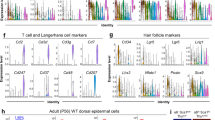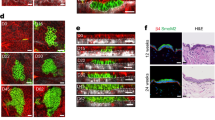Abstract
Hedgehog (HH) signaling proteins mediate inductive events during animal development1–11. Mutation of the only known HH receptor gene, Patched (PTC), has recently been implicated in inherited and sporadic forms of the most common human cancer, basal cell carcinoma (BCC)12–14. In Drosophila, HH acts by inactivating PTC function1,3, raising the possibility that overexpression of Sonic Hedgehog (SHH) in human epidermis might have a tumorigenic effect equivalent to loss of PTC function. We used retroviral transduction of normal human keratinocytes to constitutively express SHH. SHH-expressing cells demonstrated increased expression of both the known HH target, BMP-2B, as well as bcl-2, a protein prominently expressed by keratinocytes in BCCs. These keratinocytes were then used to regenerate human skin transgenic for long terminal repeat-driven SHH (LTR-SHH) on immune-deficient mice. LTR-SHH human skin consistently displays the abnormal specific histologic features seen in BCCs, including downgrowth of epithelial buds into the dermis, basal cell palisading and separation of epidermis from the underlying dermis. In addition, LTR-SHH skin displays the gene expression abnormalities previously described for human BCCs, including decreased BP180/BPAG2 and laminin 5 adhesion proteins and expression of basal epidermal keratins. These data indicate that expression of SHH in human skin recapitulates features of human BCC in vivo, suggest that activation of this conserved signaling pathway contributes to the development of epithelial neoplasia and describe a new transgenic human tissue model of neoplasia.
This is a preview of subscription content, access via your institution
Access options
Subscribe to this journal
Receive 12 print issues and online access
$209.00 per year
only $17.42 per issue
Buy this article
- Purchase on Springer Link
- Instant access to full article PDF
Prices may be subject to local taxes which are calculated during checkout
Similar content being viewed by others
References
Ingham, P.W. Signalling by Hedgehog family proteins in Drosophila and vertebrate development. Opin. Gene Dev. 5, 492–498 (1995).
Nusslein-Volhard, C. & Wieschaus, E. Mutations affecting segment number and polarity in Drosophila. Nature 287, 795–801 (1980).
Chen, Y. & Struhl, G. Dual roles for patched in sequestering and transducing Hedgehog. Cell 87, 553–563 (1996).
Hammerschmidt, M., Brook, A. & McMahon, A.P. The world according to Hedgehog. Trends Genet. 13, 14–21 (1997).
Tabata, T. & Kornberg, T.B. Hedgehog is a signaling protein with a key role in patterning Drosophila imaginal discs. Cell 76, 89–102 (1994).
Riddle, R.D., Johnson, R.L., Laufer, J. & Tabin, C. Hedgehog mediates the polarizing activity of the ZPA. Cell 75, 1401–1416 (1993).
McMahon, A.P. & Chuang, P.-T. Hedgehogs in the clinic. Nature Med. 2, 1308–1310 (1996).
Echelard, Y. et al. Sonic Hedgehog, a member of a family of putative signaling molecules, is implicated in the regulation of CNS polarity. Cell 75, 1417–1430 (1993).
Chiang, C. et al. Cyclopia and defective axial patterning in mice lacking Sonic Hedgehog gene function. Nature 383, 407–413 (1996).
Belloni, E. et al. Identification of Sonic Hedgehog as a candidate gene responsible for holoprosencephaly. Nature Genet. 14, 353–356 (1996).
Roessler, E. et al. Mutations in the human Sonic Hedgehog gene cause holoprosencephaly. Nature Genet. 14, 357–360 (1996).
Hahn, H. et al. Mutations of the human homolog of Drosophila patched in the nevoid basal cell carcinoma syndrome. Cell 85, 841–851 (1996)
Johnson, R.L. et al. Human homolog of patched, a candidate gene for the basal cell nevus syndrome. Science 272, 1668–1671 (1996).
Gailani, M.R. et al. The role of the human homologue of Drosophila patched in sporadic basal cell carcinomas. Nature Genet. 14, 78–81 (1996).
Ingham, P.W. & Hidalgo, A. Regulation of wingless transcription in the Drosophila embryo. Development 117, 283–291 (1993).
Bitgood, M.J. & McMahon, A.P. Hedgehog and Bmp genes are coexpressed at many diverse sites of cell-cell interaction in the mouse embryo. Dev. Bid. 172, 126–138 (1995).
Oro, A.E. et al. Basal cell carcinomas in mice overexpressing Sonic Hedgehog. Science 276, 817–821 (in press).
Jinnah, H.A. et al. Dopamine deficiency in a genetic mouse model of Lesch-Nyhan disease. J. Neurosci. 14, 1164 (1994).
Snouwaert, J.N. et al. A murine model of cystic fibrosis. Am.J. Resp. Crit. Care Med. 151, S59 (1995).
Porter, J.A. et al. The product of Hedgehog autoproteolytic cleavage active in local and long-range signalling. Nature 374, 363–366 (1995).
Bumbrot, D.A., Takada, R. & McMahon, A.P. Proteolytic processing yields two secreted forms of Sonic Hedgehog. Mol. Cell. Biol. 5, 2294–2303 (1995).
Morales-Ducret, C.R., van de Rijn, M., LeBrun, D.P. & Smoller, B.R. bcl-2 expression in primary malignancies of the skin. Arch. Dermatol. 131, 909–12 (1995).
Medalle, D.A. et al. Evaluation of human skin reconstituted from composite grafts of cultured keratinocytes and human acellular dermis transplanted to athymic mice. J. Invest. Dermatol. 107, 121–127 (1996).
Choate, K.A., Kinsella, T.M., Medalie, D.A., Morgan, J.R. & Khavari, P.A. Corrective gene transfer in the human skin disorder lamellar ichthyosis. Nature Med. 2, 1263–1267 (1996).
Lever, W.F. & Schaumberg-Lever, G. Histopathology of the Skin. pp. 622–634 (Lippincott, Philadelphia, 1990).
Miller, S.J. Biology of basal cell carcinoma (Part I). J. Am. Acad. Dermatol. 24, 1–13 (1991).
Miller, S.J. Biology of basal cell carcinoma (Part II). J. Am. Acad. Dermatol. 24, 161–75 (1991).
Fairley, J.A., Heintz, P.W., Neuburg, M., Diaz, L.A. & Giudice, G.J. Expression pattern of the bullous pemphigoid-180 antigen in normal and neoplastic epithelia. Br. J. Dermatol. 133, 385–91 (1995).
Savoia, P., Trusolino, L., Pepino, E., Cremona, O. & Marchisio, P.C. Expression and topography of integrins and basement membrane proteins in epidermal carcinomas: Basal but not squamous cell carcinomas display loss of alpha 6 beta 4 and BM-600/nicein. J. Invest. Dermatol. 101, 352–8 (1993).
Arbeit, J.M. Transgenic models of epidermal neoplasia and multistage carcinogenesis. Cancer Surv. 26, 7–34 (1996).
van den Heuvel, M. & Ingham, P.W. Smoothened encodes a receptor-like serpentine protein required for Hedgehog signalling. Nature 382, 547–551 (1996).
Stone, D.M. et al. Vertebrate homologues of patched and smoothened compose a receptor for Sonic Hedgehog. Nature 384, 129–133 (1996).
Alcedo, J., Ayzenzon, M., Von Ohlen, T., Noll, M. & Hooper, J.E. The Drosophila smoothened gene encodes a seven-pass membrane protein, a putative receptor for the Hedgehog signal. Cell 86, 221–232 (1996).
Hardy, M.H. The secret life of the hair follicle. Trends Genet. 8, 55–61 (1992).
Sands, A.T., Abuin, A., Sanchez, A., Conti, C.J. & Bradley, A. High susceptibility to ultraviolet-induced carcinogenesis in mice lacking XPC. Nature 377, 162–5 (1995).
Marigo, V. et al. Cloning, expression, and chromosomal location of SHH and IHH: Two human homologues of the Drosophila segment polarity gene Hedgehog. Genomics 28, 44–51 (1995).
Kinsella, T.M. & Nolan, G.P. Use of Epstein-Barr virus episomes for rapid, stable, high-titer retrovirus production. Hum. Gene Ther. 7, 1405–1413 (1996).
Choate, K.A., Kinsella, T.M., Williams, M.L., Nolan, G.P. & Khavari, P.A. Transglutaminase 1 gene delivery to lamellar iehthyosis keratinocytes. Hum. Gene Ther. 7, 2247–2253 (1996).
Rheinwald, J.G. & Green, H. Serial cultivation of strains of human epidermal keratinocytes. Cell 6, 331 (1975).
Khavari, P.A., Peterson, C.L., Tamkun, J.W., Mendel, D.B. & Crabtree, G.R. BRG1 contains a conserved domain of the SWI2/SNF2 gene family necessary for normal mitotic growth and transcription. Nature 366, 170 (1993).
Murphy, G.F., Flynn, T.C., Rice, R.H. & Pinkus, G.S. Involucrin expression in normal and neoplastic human skin: A marker for keratinocyte differentiation. J. Invest. Dermatol. 82, 453–457 (1984).
Dale, B.A., Gown, A.M., Fleckman, M.D., Kimball, J.R. & Resing, K.A. Characterization of two monoclonal antibodies to human epidermal keratohyalin: Reactivity with filaggrin and related proteins. J. Invest. Dermatol. 88, 307–313 (1987).
Liu, Z. et al. A passive transfer model of the organ-specific autoimmune disease, bullous pemphigoid, using antibodies generated against the hemidesmosomal antigen, BP180. J. Clin. Invest. 92, 2480 (1993).
Marinkovich, M.P. et al. Basement membrane proteins kalinin and nicein are structurally and immunologically identical. Lab. Invest. 69, 295–9 (1993).
Purkis, P.E. et al. Antibody markers of basal cells in complex epithelia. J. Cell Sci. 97, 39–50 (1990).
Author information
Authors and Affiliations
Rights and permissions
About this article
Cite this article
Fan, H., Oro, A., Scott, M. et al. Induction of basal cell carcinoma features in transgenic human skin expressing Sonic Hedgehog. Nat Med 3, 788–792 (1997). https://doi.org/10.1038/nm0797-788
Received:
Accepted:
Issue Date:
DOI: https://doi.org/10.1038/nm0797-788
This article is cited by
-
Congenital embryonal rhabdomyosarcoma caused by heterozygous concomitant PTCH1 and PTCH2 germline mutations
European Journal of Human Genetics (2018)
-
Zinc and zinc-containing biomolecules in childhood brain tumors
Journal of Molecular Medicine (2016)
-
Use of Drawing Lithography-Fabricated Polyglycolic Acid Microneedles for Transdermal Delivery of Itraconazole to a Human Basal Cell Carcinoma Model Regenerated on Mice
JOM (2016)
-
Patched 1 and Patched 2 Redundancy Has a Key Role in Regulating Epidermal Differentiation
Journal of Investigative Dermatology (2014)
-
Somatic Correction of Junctional Epidermolysis Bullosa by a Highly Recombinogenic AAV Variant
Molecular Therapy (2014)



